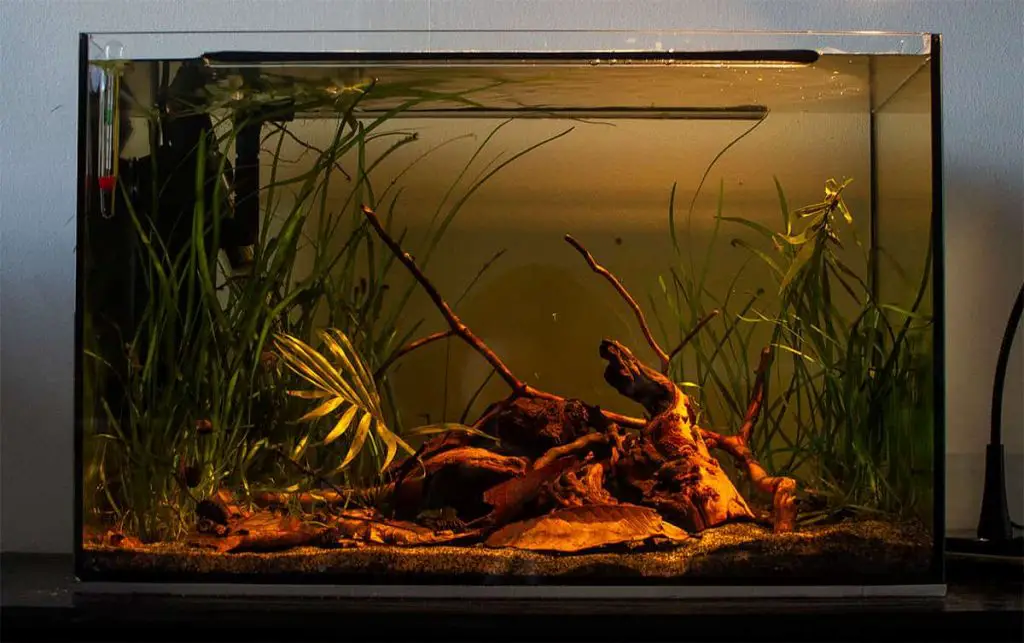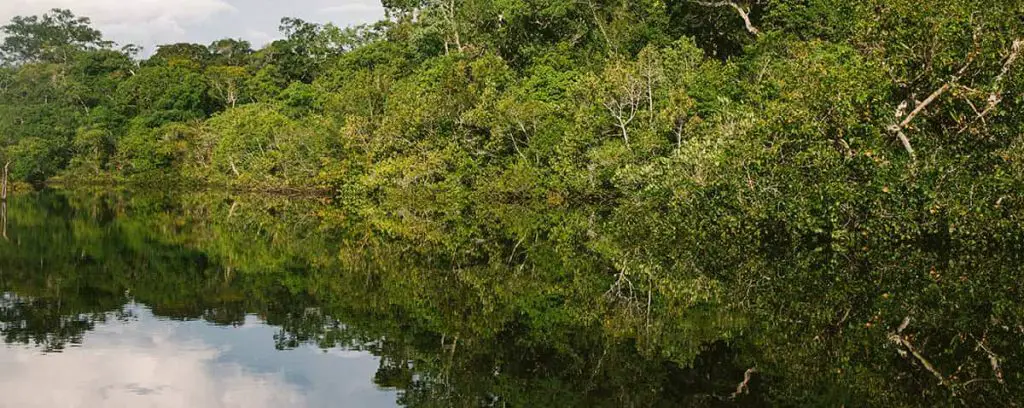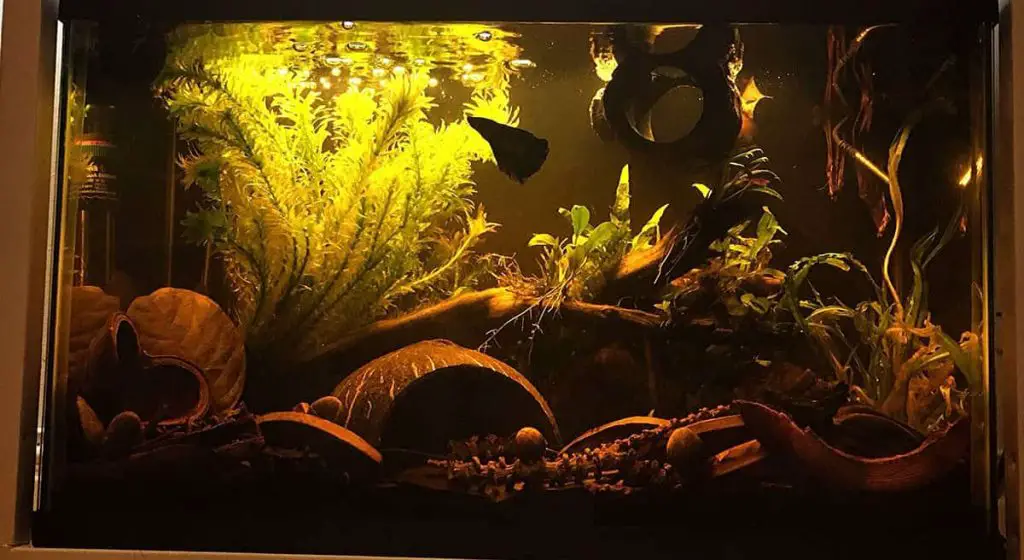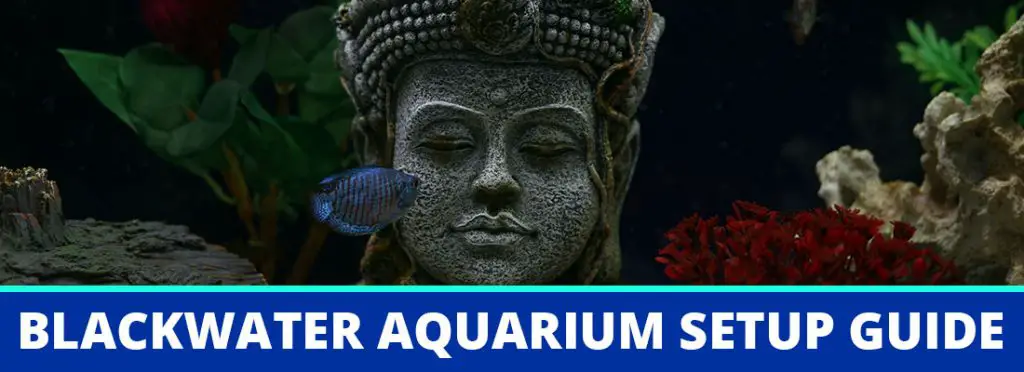The first time I saw a blackwater biotope – or blackwater aquarium – I had no idea that’s what I was looking at. I noticed that the water seemed darker than usual, the fish didn’t pop as much, and the whole thing just felt more natural than the brightly lit, bedazzled tanks I usually saw in friends’ homes (and my own). If you’ve seen one, you likely haven’t realized it, either, until you start studying this article.
But for any hobbyist who’s looking for an interesting challenge or wants to create something unique or more natural in their own aquarium, a black water fish tank may well be your thing.
Before we dig in, I do want to stress that a blackwater biotope is not for beginners. Study up, learn how to keep a healthy whitewater aquarium for a while, and then pursue these, if still interested, if you don’t already have a bit of experience.
What is a Blackwater Aquarium?

An Amazon blackwater biotope is a dark water aquarium that emulates the darker waters of the Amazon. Technically, the Amazon River and its tributaries are classified as either whitewater or blackwater.
We are generally more familiar with the whitewater habitats, which have a neutral pH of 7.0 and relatively clear water. A blackwater habitat, however, has dark-colored though transparent water that has large amounts of dissolved humic substances in the water. Often this is because of leaf litter, decomposing plants and fruit and wood, and similar debris, as the dark water is often found in the floodplains.
This particular environment is called a root forest or igapo in Brazil, and happens to be home to over 200 species of freshwater fish.
A blackwater aquarium doesn’t literally have inky black H2O in it, but it does have water that’s dark enough that most plants and fish cannot thrive in it. Fish are virtually invisible swimming around in there, which some folks find off, but there are a number of great reasons these aquariums do appeal.
Generally speaking, a blackwater biotope is going to be a great project for someone who’s looking for an interesting challenge in creating an environment that closely simulates the natural environment for freshwater critters and fish. For many hobbyists, this challenge is a fun, unique way to dig deeper into the aquarist hobby without having to spend a fortune on additional equipment and expensive species.
A blackwater aquarium is also beneficial for many fish species, especially those that were caught in the wild. The blackwater aquarium more naturally emulates their native environment, which can reduce stress levels and boost morale for the fish, especially during breeding season.
Characteristics of the Water in a Blackwater Aquarium
There are a number of different blackwater biotopes to recreate in an aquarium. There are, however, some specific characteristics that are consistent across all of these.
First off, of course, is that dark water that gives these habitats their name. Dark water typically ranges from a slightly tea-colored tint to deeply dark brown water. This color comes from the tannins that naturally occur in the plants that “contaminate” the water with their leaves, branches, and other debris.
This color in an aquarium is created the same way. If you’ve read up on many species, you’ll note that things like driftwood produce tannins and are usually expected to be treated before use in an aquarium to keep the water clear and to avoid changing the parameters of the water.
In this case, you use driftwood and similar objects are how to make dark water tank naturally.
Secondly, the water in blackwater aquariums is acidic and soft.
Thirdly, blackwater biotopes tend to be scantily planted or have no plants at all. But even if you do love planted tanks, trust me, there are many blackwater plants options around.

How to Set Up a Blackwater Aquarium
Let’s take a look at how to make blackwater aquarium, with very specific elements you’ll need.
Substrate
Technically, you can use clean, clear sand for your blackwater setup, but fine gravel is the best option to anchor your plants and provide a root zone. Amazonian fish like to sift through this type of substrate, looking for live foods.
Use light colored natural gravels or darker specialty substrates designed for planted aquariums.
Lighting
A blackwater biotope is naturally dimly lit and shadowy. So, you need to know how to light a blackwater aquarium to recreate this. Ideally you’ll use colored or white LEDs with specialized settings to create light ripples through your aquarium that emulate the natural movement of light through trees in the Amazon jungle.
Experiment with the color spectrum to create the perfect light blend for bringing out the colors of your fish and plants.
Water Chemistry – Part 1 of How to Make the Water Dark
For creating your biotope, you need soft, acidic water. Tannins naturally bring the pH down a bit, but you’ll have to do some things to create that right chemistry. Using reverse osmosis water is particularly a good way to do this, especially if you have hard tap water.
Technically, matching the natural pH of blackwater rivers is rather unrealistic, as that can be as low as 4.5, but 7 or lower is your target and can be done. Leaves and alder cones, for example, can be soaked, boiled, and filtered to create a strong blackwater “extract” or you can simply spread them along the bottom of the tank to create it more naturally.
Some kits that will help make this chemistry balance easier include:
- Water hardness test kit
- Low-range pH test kit
- Ammonia & Nitrite test kit
Heater
Your blackwater aquarium is home to tropical fish who need to be housed in a warmer water temperature. We highly recommend using a simple submersible heater to stabilize the temperature between 75 and 80 degrees.
Water Movement
Smaller black water fish tanks will do fine with a HOB power filter for water movement. Larger tanks, though, like 35+ gallons, should have power heads or canister filters to provide more powerful, natural water movement in the aquarium.
If you choose to have live plants, take care not to agitate the water surface too much, though, to prevent driving off the carbon dioxide that the plants need. If you don’t have plants, you can aerate the water as much as you desire.
Filtration
Mechanical filtration is necessary in a blackwater tank to help remove some of the debris. Using activated carbon filtration for one week per month can also be beneficial.
If you notice the water is getting too dark, increase the activated carbon usage, cleaning it weekly to reduce the staining of the water.
Driftwood
One especially nice thing about blackwater tanks is that you can use any kind of driftwood that’s safe for aquariums but you don’t have to treat it first. In fact, you don’t want to boil the driftwood as you usually wood, as you want the wood to release the tannins into the water.
A great option with a neutral pH is Manzanita wood. It happens to look pretty fantastic in there, too.

Rocks
Basically any kind of treated rock can be used in your blackwater aquarium. Be sure to avoid any jagged edges to keep your fish safe, but either smooth or rough rocks work. The key is to make sure that the rock is treated to prevent release of calcium, alkalinity, or microbes into the water. Don’t use rocks you retrieve from a stream or river yourself.
Leaf Litter – Part 2 of How to Make the Water Dark
The main, easy way to create the blackwater in your aquarium is through the use of leaf litter. You can use a variety of leaves, but not all leaves are equal.
Recommended leaves and natural debris options include:
- Indian almond
- Alder cones
- Red oak
- Turkey oak
- Pedunculate
- Sessile oak
- European beech
- Hawthorn
- Japanese maple
Blackwater Aquarium Plants
The final element you’ll need to consider for your blackwater setup is the plants. You don’t want to include many, if any, in your blackwater setup, or you’ll have other issues and concerns – such as lighting that doesn’t work well for both plants and the water setup.
The best plants to consider adding include low light plants such as:
- Anubias
- Amazon sword
- Amazon frogbit
- Bucephalandra
- Cryptocoryne
- Red tiger lotus
- Java fern
- Java moss
- Water sprite
- Taxiphyllum
Blackwater Aquarium Setup for Bettas (Video)
What Fish Do Well in Blackwater Tanks?
Finally, and one of the most important parts of your blackwater tank, is finding and stocking the best blackwater aquarium fish.
Immediately, the question comes to mind, can you have a blackwater betta tank? These popular fish naturally live in a blackwater environment, so yes, you can have a blackwater betta tank. You’ll need to keep the usual things in mind for keeping bettas along with care for your blackwater tank.
For those interested in blackwater fish other than bettas, there are many options, including fish from the Amazon region, Asia, and Africa.
South American Blackwater Fish
- Tetras
- German blue ram cichlids & other dwarf Cichlids
- Firemouth cichlids
- Angelfish
- Discus
- Hatchetfish
- Corydoras
- Farlowell
- Laoricarids
- Blackwater neons
- Neon tetras
- Cardinal tetras
- Geophagus
- Brycon species
- Pimelodus catfish
- Loricariid catfish
- Uaru
- Apistogramma
Asian Blackwater Fish
- Betta
- Barbs
- Danios
- Red Tail sharks
- Knife fish
- Gourami
- Glass catfish
- Asian clown and dwarf loaches
- Kuhli loach
- Glass catfish
- Rasboras
- Dwarf pufferfish
African Blackwater Fish
- Kribensis cichlid
- Congo tetra
- Hemichromis cichlids
Fun read: 7 Crazy Aquarium Stories


Great article, very educational and helpful. I’m getting ready to start my very first blackwater tank very soon, as I write this I’m gathering all of the materials needed for my soon to be blackwater setup. You can check out the video on my YouTube channel Majestic Cichlids.